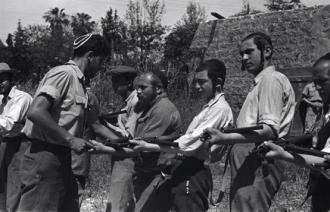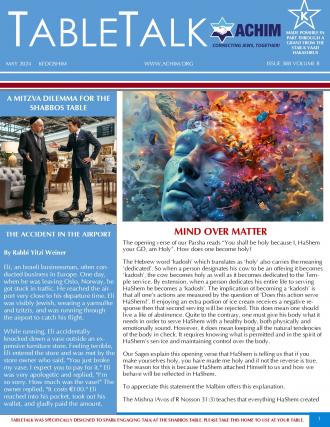There are companies out there that specialize in making wigs (sheitels) from one’s own hair.
Generally speaking, these companies do it for those undergoing chemotherapies r”l, but others are also doing it. These companies state that the hair needs to be healthy enough to withstand the hand tying process. They require a minimum of 8 ounces of hair in order to make a custom wig, and point out that the average woman has 3-4 ounces of hair on her head. The cost is about $1000 and the length of the sheitel is 3 inches shorter than the hair submitted.
Our question, however is not in regard to the cost or the process. Our question is what the halacha is regarding using one’s own hair for a sheitel. Is it permitted, forbidden, or a machlokes?
A BRIEF HISTORY
Let’s first take a look at the history of wigs before we get to our specific question. The human hair wig as we know it first appeared in ancient times, then virtually disappeared after the fall of Rome in 473 CE. It then reappeared in the last six centuries.
We find that the Egyptians wore wigs to protect against the hot sun. They attached the wigs to their head using beeswax and resin. The Assyrians, Greeks and Romans also used wigs.
The term wig, by the way, is short for periwig.
IN THE MISHNA
The Mishna in Shabbos (6:5) also attests to the use of wigs, and the Gemorah later on clearly shows that it was done for beauty. Both Rashi and the Meiri explain that it was worn so that “she would appear to be a baalas s’ar – having [much] hair.”
Rashi in Bechoros (7b) seems to add more information. He writes (D”H nehenim b’saarah), “The women who had little hair used to attach (or tie) the hair of other women to their hair and this is called peah nachris.”
THE WIG IN HALACHA
The Ramah (75:3) discusses the halacha of reciting the Shma in front of a woman who is wearing a wig. The Ramah writes that it is permitted to recite it. The Mishna Brurah explains that it is because he holds that this, the wig, is not considered “s’ar b’isha ervah. – the hair of a woman is forbidden.” There is a view that is of the opinion that wigs are forbidden because they are still considered “the hair of a women which is ervah.”
TWO VIEWS ON WIGS
Most Ashkenazic Poskim (See Igros Moshe Even HaEzer Vol. II #12) and families, however, followed the lenient opinion regarding wigs. Indeed, the Kaf haChaim (OC 75:19), Mishpetai Uziel (EH Mahadurah Tanina #74), and Yaskil Avdi (Vol. VII EH #16), all prominent Sefardi Poskim also permit the wig. On the other hand, Rav Chaim Palaji (Ruach Chaim EH 21) and Rav Ovadiah Yoseph zatzal (Yabia Omer V EH 5:4), however, follow the stringent view forbidding wigs for Sefardic women.
Rav Chaim Kanievsky Shlita stated that the Chazon Ish’s wife wore a wig (cited in Meir Oz Vol. III page 829) as did his mother. He also ruled that if a Sefardi studied in an Ashkenazic Yeshiva he may allow his wife to wear a wig, otherwise, she should cover her hair with a kerchief.
All this, of course, relates to a wig with another woman’s hair, but what about one’s own hair?
WITH ONE’S OWN HAIR
The Mishna Brurah (75:15) cites two views in this regard. The first view he cites is that of Rav Yoseph Ben Meir Teumim (1727-1793), author of the Pri Magadim. The Pri Magadim is of the opinion that use of a Peah Nochris, a sheitel, is permitted. The Mishna Brurah then states that it is indicative in the language of the Pri Magadim that he permits the use of one’s own hair in the manufacture of it as well.
THE STRINGENT VIEW
After quoting the Pri Magadim, the Chofetz Chaim then cites the view of the Mogen Giborim (written by the two brothers-in-law, Rav Yosef Shaul Nathanson [1808-1875] and Rav Mordechai Zev Ettinger [1804-1863] and published in two parts) who were stringent in this manner and forbade it.
It is also interesting to note that manuscripts of Rav Teumim have been found in the Bodleian Library at Oxford (1:1500:16419) of his work entitled “Aim LaBina” mentioned by R. Avrohom Meir Livshitz Breizel printed in 2014 which show that days before he passed away, Rav Teumim retracted his whole heter for wigs entirely. Nonetheless, we have a dictum that an author’s more authoritative work will set aside a lesser work that he wrote, even if he wrote it later.
Rav Nissim Karelitz Shlita (Chut Shaini Shabbos III page 272) writes “praised be the one who, in her tznius, can fulfill the halacha according to all opinions.” It is clear that Rav Karelitz Shlita believes that, ideally a woman should be stringent in accordance with the view of the Magain Giborim. What, however, is the view of the Mishna Brurah? What is normative halacha?
The earliest source who discusses the topic is Rav Yehoshua Boaz Ben Shimon Boruch (d. 1557) of Northern Italy, the author of the Shiltei Giborim. He writes on tractate Shabbos (64b) that the wig is permitted and it makes no difference whether it is her own hair or that of another woman. He also shows that this is clearly referring to a married woman because the Gemorah states that she wears it so that she not be found unappealing in the eyes of her husband.
The Levush, however, forbade the use of a person’s own hair, disagreeing with the Darchei Moshe in (YD 303) who indicates that it is permitted. The Ateres Zkainim also understands the Ramah as permitting it with one’s own hair.
THE BE’ER HAITEV’S VIEW
It would seem that the fact that Be’er Haitev does not even cite the more stringent view of the Levush is indicative that he holds the halacha is clearly like the Ramah – permitting it. This is borne out by the fact that in Even ha’Ezer (Siman 115) he just cites the view of the Shiltei Giborim without bringing any dissenting view which forbids it.
CONCLUSION
When the Mishna Brurah cites one authority and then a second one who is stringent, the general understanding that he rules in accordance with the first view (heard from my Rebbe zt”l, Rav Henoch Leibowitz zt”l – a relative of the Chofetz Chaim).
Also, generally speaking, the Pri Magadim is more authoritative than the Mogain Giborim. This combined with the view of the Shiltei Giborim would indicate that as a matter of pure halacha, notwithstanding the recommendation of Rav Nissim Karelitz Shlita, it would be permitted to use one’s own hair.
However, the fact that the Mishna Brurah cites the view forbidding it as well – indicates that it is not being unduly strict to be machmir.
As in all matters of halacha, however, one should always ask one’s own Rav or Posaik as to how to conduct oneself.
The author can be reached at yairhoffman2@gmail.com


















